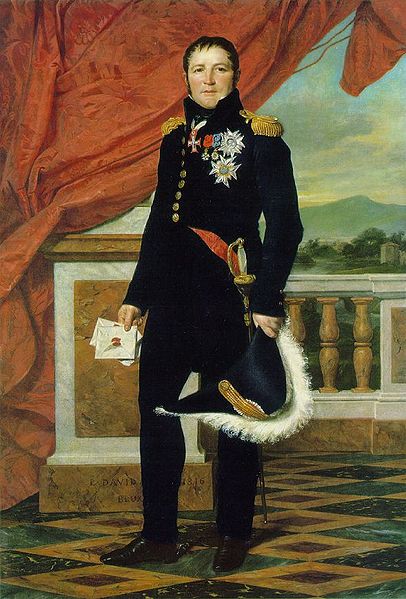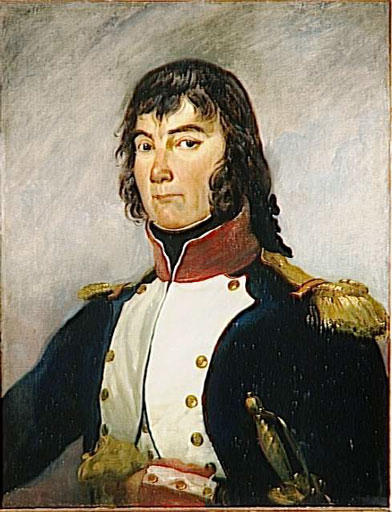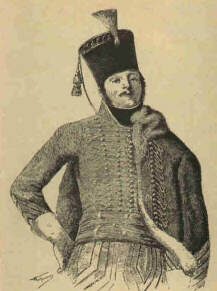<Back to Index>
- Commander of the IV Corps General Étienne Maurice Gérard, 1773
- Commander of the VI Corps General Georges Mouton, 1770
- Commander of the I Cavalry Corps General Claude - Pierre, Comte de Pajol, 1772
PAGE SPONSOR

Étienne Maurice Gérard, comte Gérard (4 April 1773 – 17 April 1852) was a French general and statesman. He served under a succession of French governments including the ancien regime monarchy, the Revolutionary governments, the Restorations, the July Monarchy, the First and Second Republics, and the First Empire (and arguably the Second), becoming Prime Minister briefly in 1834.
Born at Damvilliers, in Lorraine, he joined a battalion of volunteers in 1791, and served in the campaigns of 1792 – 1793 under Generals Charles François Dumouriez and Jean - Baptiste Jourdan.
In 1795, he served Jean - Baptiste Bernadotte as aide - de - camp. In 1799 he was promoted chef d'escadron, and in 1800 colonel.
He distinguished himself at the battles of Austerlitz and Jena, and was made Brigadier General in November 1806, and for his conduct in the battle of Wagram he was created a baron of the First French Empire.
In the Spanish campaign of 1810 and 1811, Gérard gained special distinction at the battle of Fuentes de Onoro; and in the expedition to Russia he was present at the battle of Smolensk and the battle of Valutino, and displayed such bravery and ability in the battle of Borodino that he was made général de division. He won further distinction in the disastrous retreat from Moscow.
In the campaign of 1813, in command of a division, he took part in the battle of Lützen and the battle of Bautzen, as well as in the operations of Marshal Macdonald, and at the battle of Leipzig (in which he commanded the XI Corps) he was gravely wounded. After the battle of Bautzen, he was created by Napoleon a count of the Empire.
In the Six Days Campaign of 1814, and especially at La Rothière and the battle of Montereau, he won still greater distinction.
After the first Bourbon Restoration, he was named by King Louis XVIII Grand Cross of the Legion of Honor and chevalier of St Louis. During the Hundred Days, Napoleon made Gérard a Peer of France and placed him in command of the IV Corps of the Army of the North. In this capacity Gérard took a brilliant part in the battle of Ligny, and on the morning of 18 June he was foremost in advising Marshal Grouchy to march to the sound of the guns to aid the emperor at Waterloo. Having failed in this he took part in the battle of Wavre.
Gérard retired to Brussels after the fall of Napoleon, and did not return to France until 1817. He sat as a member of the Restoration's Chamber of Deputies in 1822 – 1824, and was re-elected in 1827.
Gérard took part in the July Revolution of 1830, after which he was appointed minister of war and named a Marshal of France. On account of his health he resigned the office of War Minister in the following October.
However, in 1831 he took the command of the Northern Army, and was successful in forcing the army of the Netherlands to withdraw from Belgium (Belgian Revolution). In 1832 he commanded the besieging army in the notorious scientific siege of the citadel of Antwerp.
He was again chosen war minister in July 1834, and served as Prime Minister of the July Monarchy, but resigned in the following October. In 1836 he was named grand chancellor of the Legion of Honor in succession to Marshal Mortier, and in 1838 commander of the National Guards of the Seine département, an office which he held until 1842. He became a senator of the Second Empire in 1852 (before it was formally instituted), and died in the same year.

Georges Mouton, comte de Lobau (2 February 1770 - 21 November 1838) was a French soldier and political figure who rose to the rank of Marshal of France.
Born in Phalsbourg, Lorraine, he enlisted in the French Revolutionary Army in 1792. Serving in the early campaigns of the French Revolutionary Wars, by 1800 he was promoted to the rank of colonel.
Promoted to général de brigade in 1805, after the establishment of the French Empire, and général de division in 1807, Lobau distinguished himself in the battles of Jena and Aspern - Essling. In 1810, he was created count of Lobau in recognition of his role in the battle of Aspern.
During the Russian Campaign, he acted as a senior aide - de - camp to Emperor Napoleon I of France. He then served with distinction during the 1813 campaign, seeing action at the Battles of Lützen and Bautzen.
After Dominique Vandamme was made prisoner during the battle of Kulm, Lobau commanded the retreat of the remnants of the corps. He served under Laurent Gouvion Saint - Cyr when, upon the retreat after the battle of Leipzig, the latter was trapped in Dresden and after the surrender of these forces he became a prisoner of the Austrian Empire for the rest of the war.
During the Hundred Days, Lobau rallied to Napoleon and was made commander of the VI Infantry Corps which he led in the battles of Ligny and Waterloo. At Waterloo he distinguished himself in the defense of Plancenoit against the Prussians.
After the Second Restoration, Lobau was forced to go into exile until he was allowed to return to France in 1818. He was elected to the House of Representatives from 1828 to 1830 as a liberal, and, in 1830, he joined the July Revolution as commander of the National Guard.
As a reward for his services to King Louis - Philippe he was made a Marshal in 1831, the same year he was made a Peer of France. In 1832 and 1834, Lobau was assigned to suppress insurrections, a task in which he was successful.
George Mouton, comte de Lobau died in Paris.

Claude - Pierre, Comte de Pajol (3 February 1772 - 20 March 1844), was a French cavalry general and military commander during the French Revolutionary and Napoleonic Wars, and political figure.
Born in Besançon, as the son of a lawyer, he was intended to follow his father's profession, but the events of 1789 turned his mind in another direction. Joining the battalion of Besançon, he took part in the political events of that year, and in 1791 went to the French Revolutionary Army of the Upper Rhine with a volunteer battalion.
He took part in the campaign of 1792 and was one of the stormers at Hochheim (1793). From the Count of Custine's staff he was transferred to that of Jean Baptiste Kléber, with whom he took part in the Sambre and Rhine Campaigns (1794 - 96). After serving with Louis Lazare Hoche and André Masséna in Germany and Switzerland (1797 - 99), Pajol took a cavalry command under Jean Victor Marie Moreau for the campaign on the upper Rhine.
In the short years of peace Pajol, now colonel, was successively envoy to the Batavian Republic, and delegate at Napoleon I's coronation (the start of the First French Empire). In 1805, the emperor employed him with the light cavalry. He distinguished himself at the battle of Austerlitz, and, after serving for a short time in the Italian Peninsula, he rejoined the Grande Armée as a general of brigade, in time to take part in the campaign of Friedland. The next year (1808) he was made a Baron d’Empire.
In 1809 he served on the Danube, and in the Russian War of 1812 led a division, and afterwards a corps, of cavalry. He survived retreat, but his health was so broken that he retired to his native town of Besançon for a time. He was back again in active service, however, in time to be present at the battle of Dresden, in which he played a conspicuous part. Again wounded in the battle of Leipzig, Pajol was created a count of the Empire on 25 November 1813.
In 1814 he fought in the Six Days Campaign, commanding a corps of all arms in the Seine Valley. On the fall of Napoleon, Pajol gave in his adhesion to the Restoration
government, but he rejoined the Emperor immediately upon his return to
France. The Ist corps of cavalry under his leadership played a prominent
part in the campaign of 1815, both at Ligny and in the advance on the Wavre under the Marquis de Grouchy. On receiving the news of the battle of Waterloo, Pajol disengaged his command, and skillfully retreated to refuge in Paris. There he and his men played an active part in the actions which ended the war.
The Bourbons, on their return, dismissed him, although this treatment was not, compared to that applied to Michel Ney and others, excessively harsh. In 1830 he took part in the July Revolution and the overthrow of Charles X. He suppressed the riots in Paris in 1831 and 1832, 1834 and 1839. A general, and a peer of France, he was put on the retired list in 1842 and died two years later.
His son, Count Charles Paul Victor Pajol (1821 - 1891), entered the army and had reached the rank of général de division when, during the Franco - Prussian War, he was involved in the catastrophe of Metz (1870). He retired in 1877. Besides being judged a competent soldier, he was a sculptor of some merit, who executed statues of his father and of Napoleon, and he wrote a life of his father and a history of the wars under Louis XV (Paris 1881 - 1891).